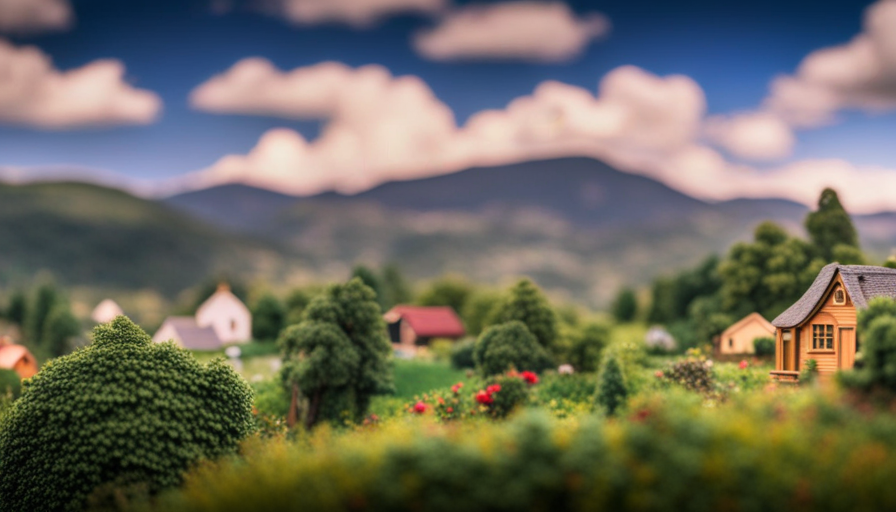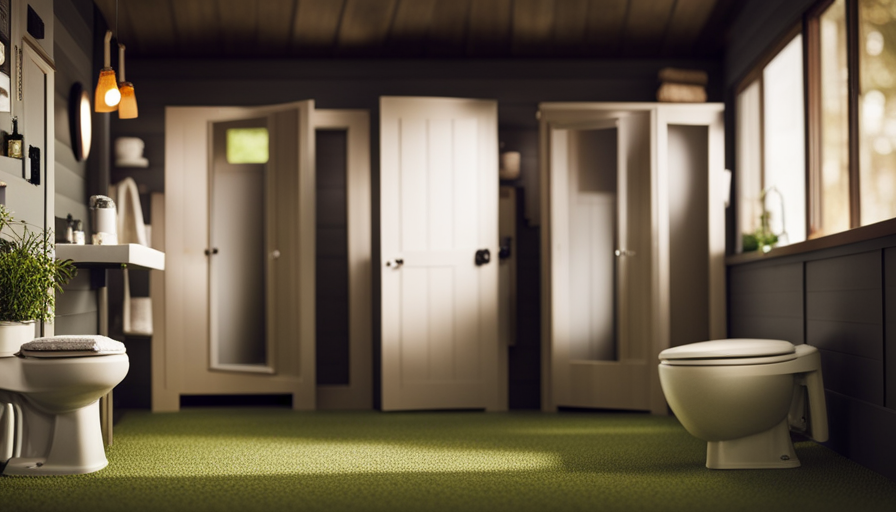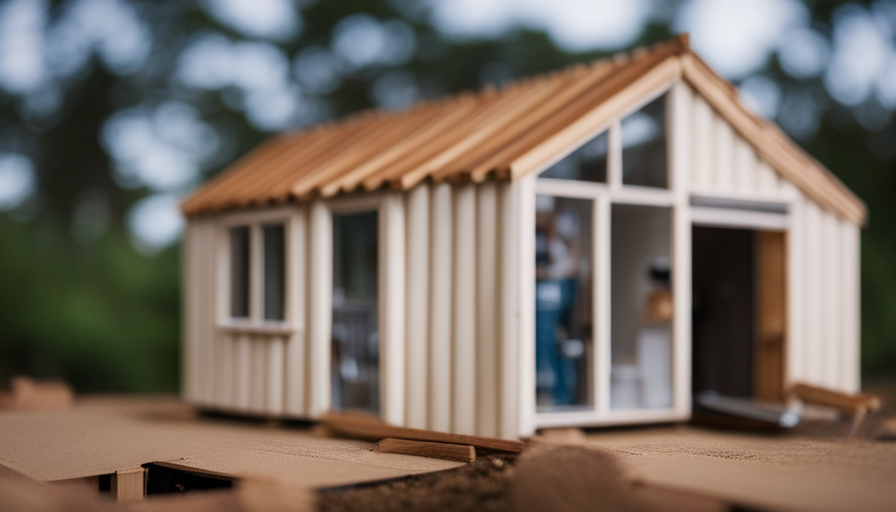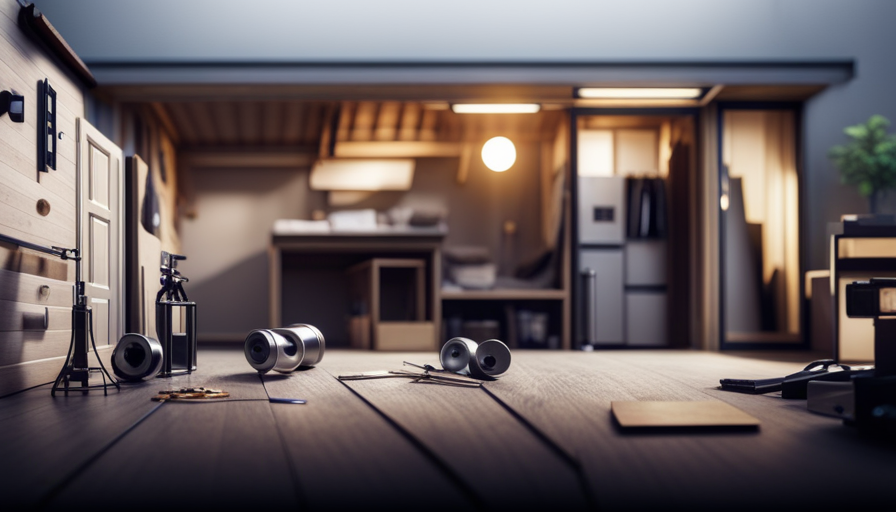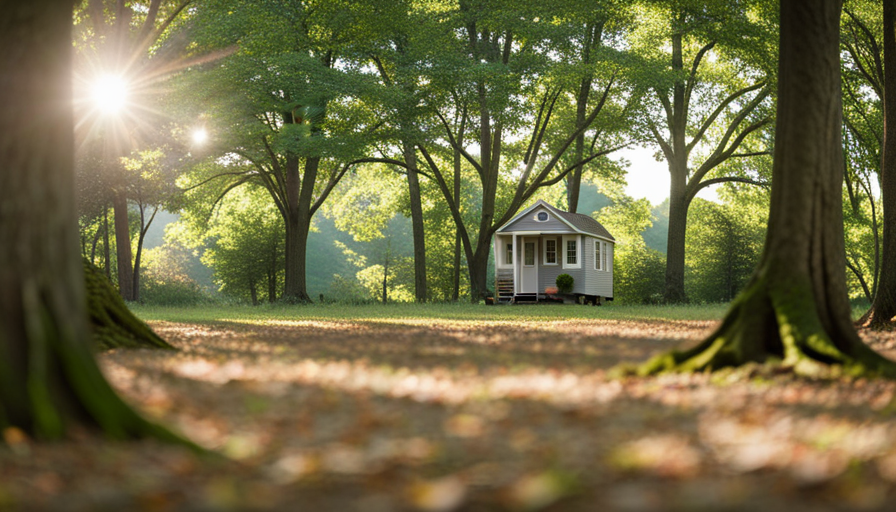Did you know that the average home size in the United States is around 2,600 square feet? That amount of space could fit over 20 tiny homes! It’s no wonder that more and more people are opting for a simpler, more minimalist lifestyle by choosing to live in tiny houses.
But where can you get one? There are actually several options available to you. You can hire custom builders who specialize in creating unique tiny homes tailored to your specific needs and preferences. Alternatively, you can choose from a wide range of pre-fabricated models that are ready to be delivered and assembled on-site.
If you prefer a sense of community, there are tiny house communities where you can either rent or buy a tiny home. You can also explore online marketplaces, local classifieds, and listings for used tiny houses. Another option is to attend tiny house expos and events where you can meet builders and see different models up close.
Lastly, if you’re feeling adventurous and handy, you can even build your own tiny house with the help of various DIY resources. No matter which path you choose, there’s a tiny house out there waiting for you to call it home.
Key Takeaways
- There are various options available for getting a tiny house, including hiring custom builders, choosing pre-fabricated models, renting or buying in tiny house communities, and exploring online marketplaces.
- Custom builders offer tailored designs and flexibility in materials and finishes, while pre-fabricated models offer convenience, time-saving, quality assurance, financing options, and customization possibilities.
- Ready-to-move-in tiny houses save time and money, often with financing options, and tiny house communities provide community support, financing options, and help with zoning laws and regulations.
- Online marketplaces offer a wide range of options and price points for buying and selling tiny houses, with customization options, financing options, and the ability to connect with sellers and learn more about available properties.
Custom Builders
Looking for a tiny house that perfectly suits your needs? Check out these amazing custom builders! When it comes to finding the perfect tiny house, custom builders are the way to go. They specialize in creating custom designs that are tailored to your specific wants and needs. Whether you want a lofted bedroom, a full-sized kitchen, or unique features like a hidden storage compartment, custom builders can bring your vision to life.
One of the advantages of working with custom builders is the ability to have complete control over the design process. You can work closely with the builder to create a layout that maximizes space and includes all the features you desire. They will take into consideration your lifestyle and preferences to ensure that the final product is both functional and beautiful.
Custom builders also offer flexibility when it comes to materials and finishes. You can choose from a wide range of options to create a space that reflects your personal style. From rustic wood accents to sleek modern finishes, the possibilities are endless.
Now, if you’re looking for a quicker and more affordable option, you might want to consider pre-fabricated models. These ready-to-go tiny houses offer convenience and efficiency, making them a popular choice for many. But more on that in the next section.
Pre-Fabricated Models
When it comes to finding a tiny house, exploring pre-built options from reputable manufacturers can be a great way to go. Not only do these manufacturers offer a variety of floor plans and designs to choose from, but they also provide the convenience of a ready-to-move-in tiny house.
This means that you can save both time and money by avoiding the lengthy construction process and having your dream tiny home delivered right to your desired location.
Explore pre-built tiny house options from reputable manufacturers
Check out reputable manufacturers who offer pre-built tiny houses, so you can easily find the perfect one for you. Here are four reasons why pre-built options may be a better choice compared to DIY alternatives:
-
Time-saving: With pre-built tiny houses, you don’t have to spend months or even years constructing your home. It arrives ready-to-live, saving you precious time.
-
Quality assurance: Reputable manufacturers ensure that their pre-built tiny houses are built to high standards, using quality materials. You can trust that your home is structurally sound and built to last.
-
Financing options: Many manufacturers offer financing options for buying a pre-built tiny house. This makes it more affordable and accessible for those who may not have the funds upfront.
-
Customization possibilities: While pre-built, these houses still offer a range of floor plans and designs to choose from. You can personalize your tiny home to fit your specific needs and preferences.
By opting for a pre-built tiny house, you can save time, ensure quality, explore financing options, and still have the freedom to choose from a variety of floor plans and designs.
Choose from a variety of floor plans and designs
Once you’ve made your decision, you can dive into a sea of endless possibilities. You have a variety of floor plans and designs to choose from for your dream home on a smaller scale. Custom designs are a popular option for those who want to personalize every aspect of their tiny house. You have the freedom to create a space that reflects your unique style and needs, from layout to interior finishes. You can even use alternative materials such as reclaimed wood or recycled metal to add a touch of sustainability to your home. These materials not only give your tiny house a distinct look but also contribute to a greener lifestyle. With so many options available, you can truly create a tiny house that is tailored to your preferences and values.
Transitioning into the subsequent section, exploring pre-built tiny house options can save you time and money while still offering a wide range of designs to choose from.
Save time and money with a ready-to-move-in tiny house
Explore the convenience of a ready-to-move-in tiny house and save both time and money in the process. When searching for a tiny house, consider the option of a ready-to-move-in model. These houses are already built and can be delivered to your desired location, eliminating the need for construction time and costs. Not only does this save you the hassle of building from scratch, but it also saves you money in the long run. Additionally, many ready-to-move-in tiny houses come with financing options, making it easier to afford your dream home. Downsizing to a tiny house offers numerous benefits, such as reduced utility costs, lower maintenance, and a simpler lifestyle. By embracing the tiny house movement, you can enjoy financial freedom and a more sustainable way of living. Transitioning to the next section, let’s explore the concept of tiny house communities.
Tiny House Communities
Are there any tiny house communities near my area where I can live a minimalist lifestyle? If you’re looking to join a community of like-minded individuals who value simplicity and sustainable living, you’re in luck.
Here are three reasons why tiny house communities might be the perfect fit for you:
-
Community support: Living in a tiny house community provides a strong sense of camaraderie and support. You can connect with others who share your passion for minimalism and exchange ideas on sustainable living practices.
-
Tiny house financing options: Many communities offer financing options specifically tailored for tiny homes, making it easier for you to own your own space without breaking the bank. These options often have lower interest rates and flexible payment terms.
-
Zoning laws and regulations: One of the biggest challenges for tiny house enthusiasts is finding a suitable place to park their homes. However, many tiny house communities have already navigated the complexities of zoning laws and regulations, ensuring that you can legally and comfortably live in your tiny home.
By joining a tiny house community, you not only gain access to a supportive network, but you also have the opportunity to learn from others and share your own experiences.
Now, let’s explore another option for finding your dream tiny house: online marketplaces.
Online Marketplaces
When it comes to finding a tiny house, online marketplaces are a great place to start. I love browsing through these platforms because they offer a wide range of options and price points to choose from.
Not only can I connect with sellers directly, but I can also learn more about the available properties and get all the information I need to make an informed decision.
Browse online platforms for buying and selling tiny houses
Check out popular online platforms like Tiny House Listings or Tiny House Marketplace to find your dream tiny house. These platforms offer a wide selection of pre-owned options and financing options to suit your needs. Whether you’re looking for a rustic cabin-style tiny house or a sleek modern design, you’ll find a variety of styles and sizes to choose from.
To give you an idea of the range of options available, take a look at the table below:
| Platform | Pre-Owned Options | Financing Options | Price Range |
|---|---|---|---|
| Tiny House Listings | Yes | Yes | $10,000 – $100,000 |
| Tiny House Marketplace | Yes | No | $5,000 – $50,000 |
As you can see, both platforms offer pre-owned options, but Tiny House Listings also provides financing options. This allows you to explore different price points and find the best fit for your budget and preferences. So, start browsing these online platforms and find a wide range of options and price points for your dream tiny house.
Find a wide range of options and price points
You’ll be amazed by the diverse selection and affordable price range of options available on popular online platforms for buying and selling tiny houses. Whether you’re looking for a cozy cabin-style tiny house or a sleek modern design, these platforms offer a wide range of customization options to suit your preferences.
From the exterior finishes to the interior layout, you can find a tiny house that truly reflects your personal style. Additionally, many platforms also provide financing options, making it easier for you to achieve your dream of owning a tiny house. With flexible payment plans and competitive interest rates, you can find a financing option that fits your budget.
So, as you explore these platforms, not only will you find the perfect tiny house, but you can also connect with sellers and learn more about available properties.
Connect with sellers and learn more about available properties
By browsing these online platforms, you can easily connect with sellers and gain valuable insights into the array of properties that are currently available for purchase. These platforms provide a convenient way to explore different options and price points for tiny houses. You can filter your search based on location, size, and other preferences to find the perfect tiny house for your needs.
Additionally, these platforms often provide essential information about local zoning regulations and financing options, helping you make informed decisions. Understanding local zoning regulations is crucial as it ensures that you can legally place your tiny house in your desired location. Furthermore, many sellers offer financing options, making it easier for you to afford your dream tiny house.
With all this information at your fingertips, you can confidently move forward in your search for the perfect tiny house that suits your needs and budget.
Now let’s delve into the exciting world of DIY construction.
DIY Construction
Finding the perfect place to build your DIY tiny house is like discovering a hidden treasure chest waiting to be unlocked. Before beginning construction, it’s important to familiarize yourself with local regulations regarding tiny houses. Each area may have specific zoning and building codes that dictate the size and location of your tiny house. Researching these regulations will ensure that you’re in compliance and avoid any potential setbacks.
Once you have a clear understanding of the regulations, it’s time to start the exciting process of building your own tiny house. There are numerous resources available online that provide step-by-step guides, plans, and tutorials to help you along the way. These resources cover everything from choosing the right materials to understanding the intricacies of plumbing and electrical systems.
Building your own DIY tiny house allows for customization and personalization. You have the freedom to design a space that perfectly suits your needs and preferences. Whether you want a minimalist, modern aesthetic or a cozy, rustic feel, the possibilities are endless.
As you embark on your DIY tiny house journey, it’s important to consider alternative options such as converted trailers or shipping containers. These can offer a cost-effective and efficient solution for your tiny house needs. By repurposing existing structures, you can save time and money while still achieving your dream of living in a tiny house.
Transitioning into the subsequent section about ‘converted trailers or shipping containers,’ let’s explore how these options can provide a unique foundation for your tiny house project.
Converted Trailers or Shipping Containers
Ready to embark on your tiny house adventure? Let’s dive into the world of converted trailers and shipping containers, where endless possibilities await for creating your dream space.
-
Versatility: Converted trailers and shipping containers offer a versatile and customizable option for your tiny house. With their sturdy structures, these units can be transformed into cozy homes, stylish offices, or even creative studios.
-
Affordability: One of the greatest advantages of choosing a converted trailer or shipping container is its affordability. These options often come at a fraction of the cost of a traditional home. By repurposing these units, you can save money while still achieving your dream of living in a tiny house.
-
Mobility: Converted trailers and shipping containers are built to be mobile. Whether you want to travel the country or simply change your scenery, these units allow you to take your home wherever you desire. Imagine waking up to breathtaking views, with the freedom to move whenever the wanderlust strikes.
-
Sustainability: By repurposing trailers or shipping containers, you’re contributing to a more sustainable future. Not only are you reducing waste by giving new life to these structures, but you can also incorporate eco-friendly features such as solar panels or rainwater harvesting systems.
As you explore the possibilities of converted trailers and shipping containers, keep in mind that there are also tiny house rental companies that offer a taste of the tiny house lifestyle. Transitioning into the next section, let’s discover the convenience and benefits of renting a tiny house.
Tiny House Rental Companies
Imagine stepping into a world of enchantment and possibility, where tiny house rental companies transport you to a realm of cozy retreats and captivating experiences. Renting a tiny house allows you to immerse yourself in the minimalist lifestyle without the commitment of building or buying your own. These rental companies offer a wide range of options, from quaint cottages nestled in the woods to sleek modern designs with panoramic views.
To give you an idea of the variety available, here is a comparison table showcasing a few popular tiny house rental companies and their prices:
| Company | Location | Rental Price per Night |
|---|---|---|
| Tiny Homes Retreat | Oregon | $100-$200 |
| Wanderlust Tiny House | Colorado | $150-$250 |
| Tiny Tranquility | California | $200-$300 |
Renting a tiny house comes with numerous benefits. Firstly, it allows you to experience the freedom of living with less and simplifying your life. You can enjoy the coziness and charm of a tiny house without the long-term commitment. Additionally, renting gives you the opportunity to try out different locations and designs before deciding if tiny house living is right for you.
As you explore the world of tiny house rentals, you may also want to consider local classifieds and listings for more options. These platforms often offer unique and affordable opportunities to rent or even purchase a tiny house.
Local Classifieds and Listings
To truly immerse yourself in the world of tiny house living, explore the hidden gems of local classifieds and listings, where a realm of unique and affordable opportunities await.
These local platforms are a treasure trove of converted school buses and other tiny house options that you won’t find anywhere else. Whether you’re looking for a cozy cabin on wheels or a quirky container home, local classifieds can connect you with homeowners who are ready to rent or sell their tiny houses.
One advantage of searching through local listings is the ability to find tiny house financing options. Many sellers offer flexible payment plans or even rent-to-own arrangements, making it easier for you to take the leap into tiny house living. Plus, by dealing directly with the owners, you can negotiate prices and terms that suit your budget and lifestyle.
In addition to buying or renting, local classifieds also provide a great platform to connect with others in the tiny house community. You can find like-minded individuals who are passionate about tiny living and exchange tips, advice, and even potential partnership opportunities.
As you explore the world of tiny houses through local listings, don’t forget to mark your calendar for upcoming tiny house expos and events. These gatherings bring together enthusiasts, builders, and vendors to showcase the latest trends in tiny house living. From workshops on sustainable living to tours of innovative tiny house designs, these events offer a wealth of knowledge and inspiration for anyone interested in the tiny house lifestyle.
Tiny House Expos and Events
Don’t miss out on the incredible experience of attending tiny house expos and events, where you’ll be immersed in a world of innovation, inspiration, and endless possibilities for your dream home. These gatherings bring together passionate tiny house enthusiasts, builders, and experts in one place, creating a vibrant atmosphere buzzing with ideas and creativity.
Here’s what you can expect when you attend a tiny house expo or event:
-
Inspiring Displays: Picture rows of beautifully crafted, fully furnished tiny houses, each showcasing unique designs and creative space-saving solutions. These displays will give you a firsthand look at what’s possible in the world of tiny houses.
-
Informative Workshops: Learn from industry professionals about the latest trends in tiny house construction, design, and sustainability. From understanding financing options to navigating zoning regulations, these workshops will equip you with the knowledge needed to make informed decisions for your tiny house journey.
Attending these expos and events is a great way to connect with like-minded individuals, gain valuable insights, and get inspired. Once you’re armed with the knowledge and ideas you’ve gathered, it’s time to consult with tiny house experts to turn your vision into a reality.
Consult with Tiny House Experts
When it comes to diving into the world of tiny house living, it’s crucial to seek advice from experienced tiny house builders and owners. These experts can provide valuable insights and recommendations on finding the right tiny house that suits your needs and budget.
Additionally, they can offer guidance on navigating the regulations and legal considerations that come with tiny house living. This ensures that you are well-informed and prepared for this unique lifestyle.
Seek advice from experienced tiny house builders and owners
Seeking advice from experienced tiny house builders and owners can provide valuable insights and guidance in finding the right place to get a tiny house. These experts have firsthand knowledge of the industry and can offer recommendations on reputable builders and sellers. They can also provide insights into the custom features available and help you navigate the financing options.
By consulting with these individuals, you can gain a better understanding of what to look for in a tiny house and make informed decisions. Additionally, they can share their experiences and offer tips on what to consider when purchasing a tiny house. With their guidance, you can avoid common pitfalls and find a tiny house that meets your specific needs and preferences.
Transitioning into the next section, getting recommendations and guidance on finding the right tiny house is an essential step in the process.
Get recommendations and guidance on finding the right tiny house
One interesting statistic to consider is that according to a survey of tiny house owners, 85% reported that seeking recommendations and guidance from experienced individuals was crucial in finding their perfect home.
When it comes to finding the right tiny house, it’s important to weigh the options of pre-built vs. custom-built. Pre-built tiny houses offer the convenience of being ready to move in immediately, while custom-built tiny houses allow for personalization and the ability to design a home that meets specific needs and preferences. Both options have their pros and cons, so it’s important to carefully consider what is most important to you.
Living in a tiny house has its advantages, such as lower costs, reduced environmental impact, and simplified living. However, it’s also important to be aware of the potential challenges like limited space and the need to adhere to zoning and building regulations. Understanding these considerations will help you make an informed decision about your tiny house journey.
Moving forward, let’s learn about regulations and legal considerations for tiny house living.
Learn about regulations and legal considerations for tiny house living
Now that we’ve explored recommendations and guidance for finding the right tiny house, let’s delve into the important topic of regulations and legal considerations for tiny house living.
It’s crucial to be aware of the specific regulations and zoning laws in your area before embarking on your tiny house journey. These regulations can vary greatly from place to place, so it’s essential to do thorough research and understand what’s allowed and what’s not.
Additionally, financing options are another aspect to consider. While tiny houses can be a more affordable housing solution, it’s still important to explore different financing options that are available to you. Whether it’s through personal savings, loans, or other creative financing methods, understanding your options will enable you to make informed decisions as you embark on your tiny house adventure.
Frequently Asked Questions
Are there any zoning restrictions or regulations that I need to be aware of before building or parking a tiny house?
Yes, there are zoning regulations and parking restrictions that you need to be aware of before building or parking a tiny house. It’s important to research and comply with the specific regulations in your area to avoid any legal issues.
What are the average costs associated with building or buying a tiny house?
The average costs of building or buying a tiny house can vary depending on factors such as size, materials, and location. Financing options like personal loans or RV loans can help make owning a tiny house more affordable.
Can I finance a tiny house purchase or construction?
Sure! Financing options for purchasing or building a tiny house are available. Pros include the ability to start your tiny house journey sooner. Cons include interest rates and potential debt.
Are there any specific building codes or safety standards that apply to tiny houses?
Yes, there are specific building code requirements and safety standards that apply to tiny houses. These regulations are in place to ensure the safety and structural integrity of the homes.
How can I ensure that my tiny house is energy efficient and sustainable?
To ensure my tiny house is energy efficient and sustainable, I would focus on using energy-efficient design techniques, such as proper insulation, solar panels, and energy-efficient appliances. Additionally, I would opt for sustainable materials like reclaimed wood and eco-friendly insulation.
Conclusion
After exploring various options, I’ve learned that there are numerous ways to get a tiny house. From custom builders to pre-fabricated models, tiny house communities to online marketplaces, and even DIY construction, the possibilities are endless.
However, one statistic that truly struck me is that there are over 10,000 tiny house rentals available across the United States. This staggering number highlights the growing popularity of tiny living and the increasing desire for people to experience the minimalist lifestyle firsthand. It’s truly remarkable to see how the tiny house movement has flourished and continues to capture the hearts of individuals seeking simplicity and freedom.
Hi, I’m Emma. I’m the Editor in Chief of Tiny House 43, a blog all about tiny houses. While tree houses are often associated with childhood, they can be the perfect adult retreat. They offer a cozy space to relax and unwind, surrounded by nature. And since they’re typically built on stilts or raised platforms, they offer stunning views that traditional homes simply can’t match. If you’re looking for a unique and romantic getaway, a tree house tiny house might just be the perfect option.
